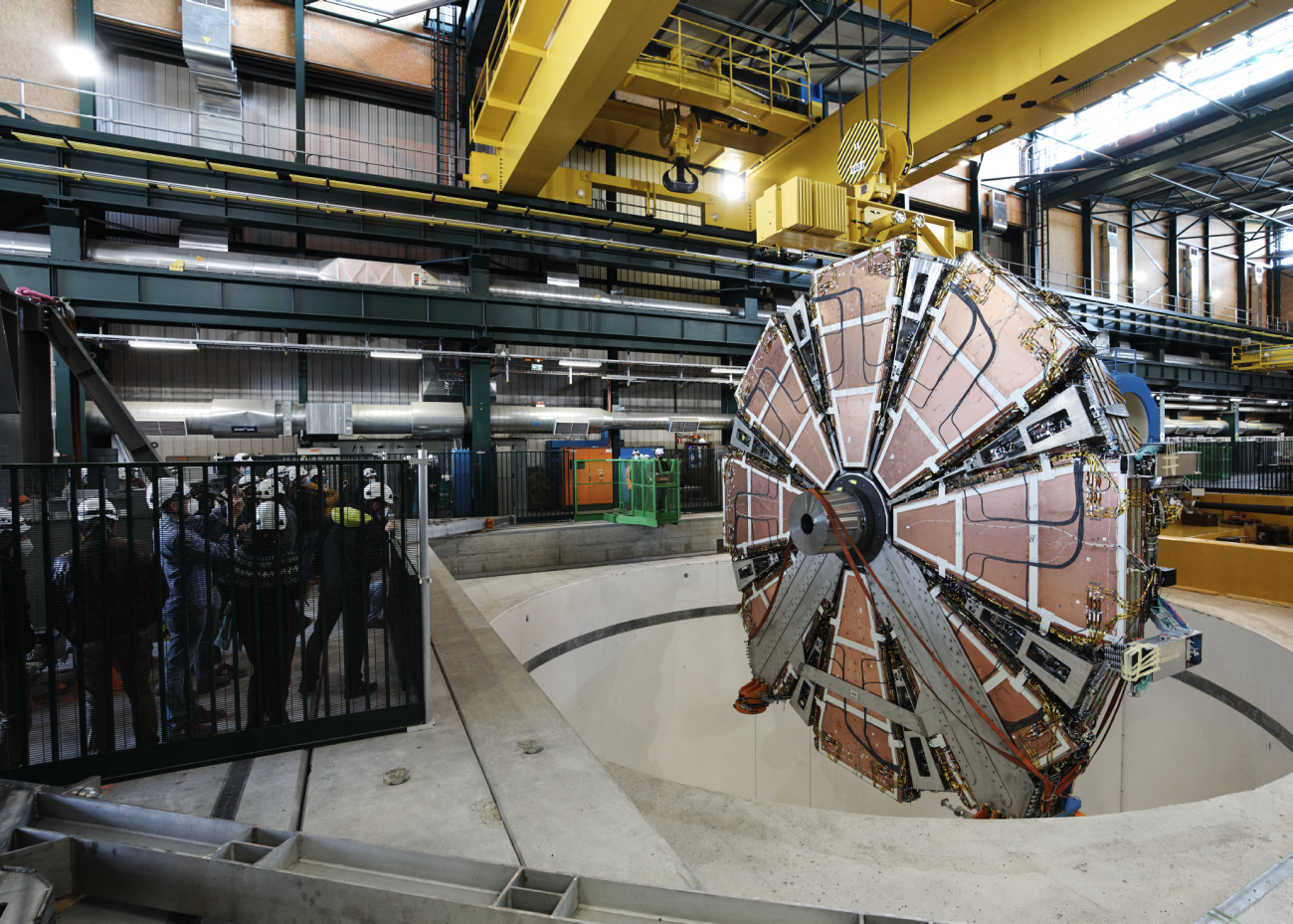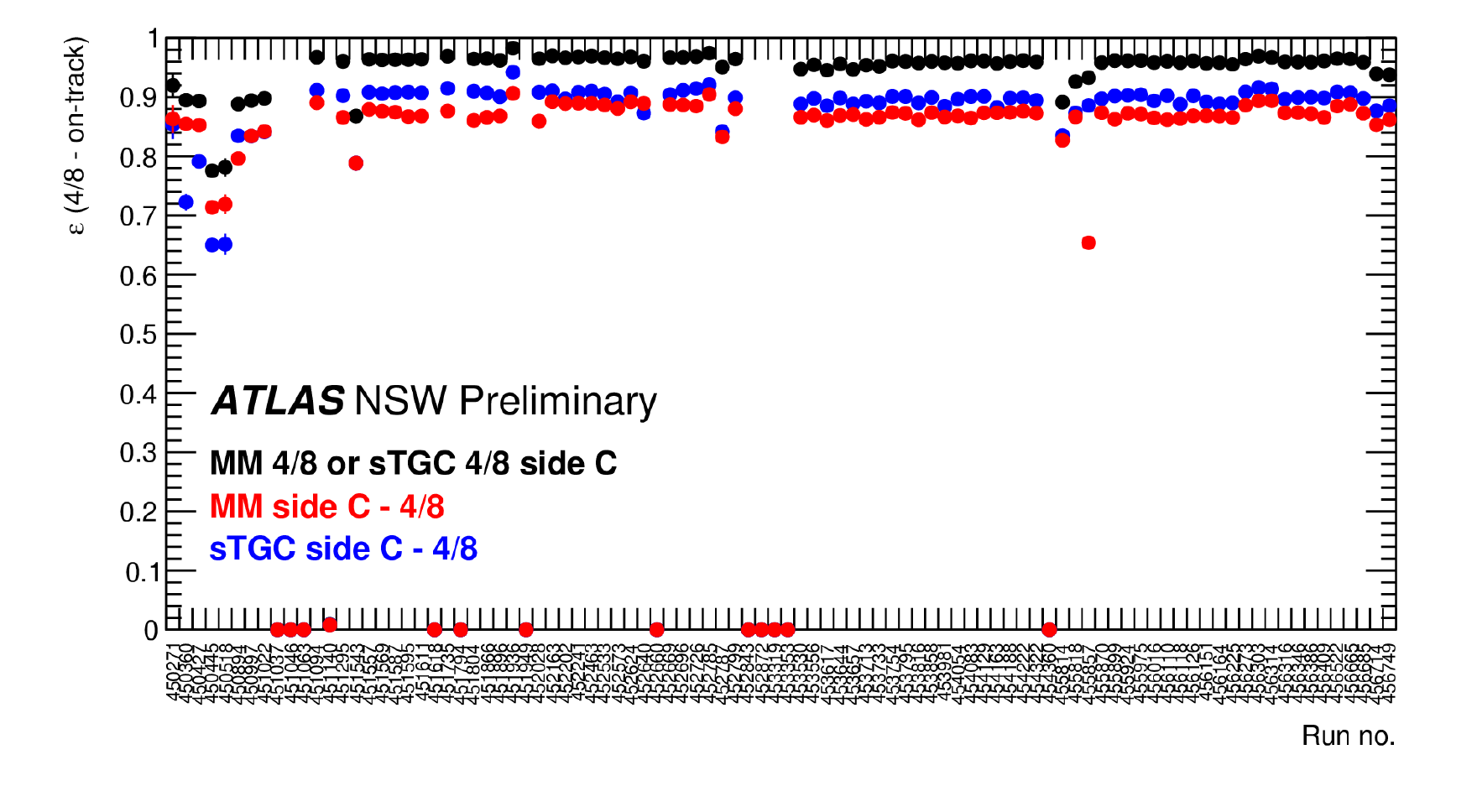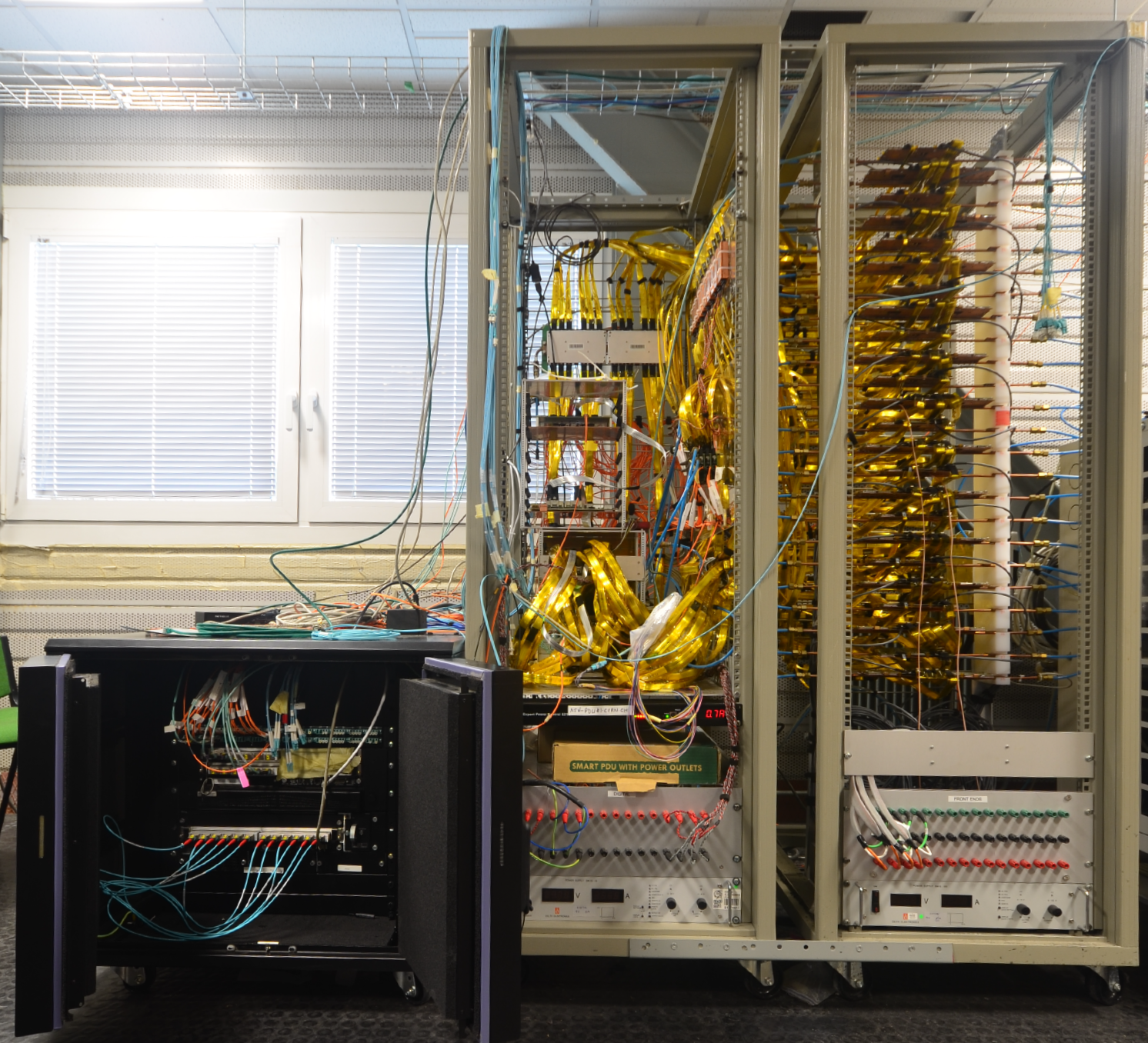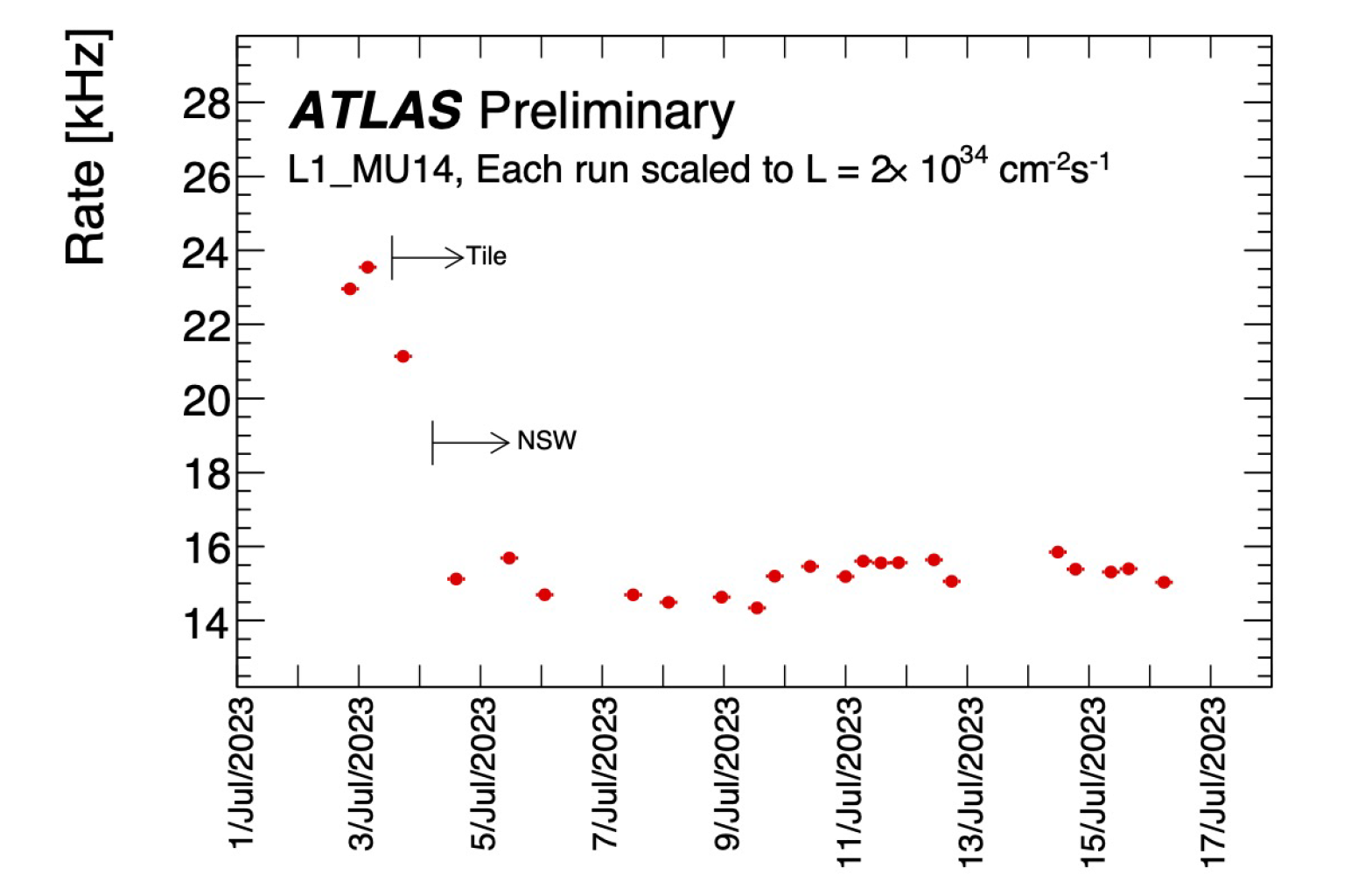The ATLAS New Small Wheel - Triggering on muons and rejecting fakes

The New Small Wheel (NSW) [1] has been the largest Phase-1 upgrade project of ATLAS. The two innermost stations of the Endcap Muon spectrometer have been replaced with two newly built detector systems based on small-strip Thin Gap Chambers (sTGC) and Micromegas (MM). Both technologies cover an active area of about 1280 m2, with a total number of NSW readout channels close to 2.5 M.
The NSW was designed to provide sizeable fake trigger reduction and to contribute to the precise muon tracking in the pseudo-rapidity range 1.3< |η| <2.7. In spite of the challenging project and the 2020 pandemic, the NSW was successfully completed and installed in the ATLAS cavern on time for the start of Run3 [2] (see the photograph at the top of this article). The first months of operations in 2022 have been devoted to the commissioning of the system, which has now reached a stable level of performance (see Fig 1); while the major achievement in 2023 has been the deployment of the sTGC pad trigger path.
Both sTGC and Micromegas detectors contribute to the NSW trigger decision with distinct algorithms. In particular, sTGC uses the signals from the readout pads, with coarse granularity, to identify up to four trigger towers for each trigger sector. A trigger tower defines a band of sTGC strips (3.2 mm pitch) where a trigger signal is searched for. The full NSW trigger potential, which includes MM and sTGC strip triggers, is required to face the high rate expected in pp collisions at 5 x 1034cm−2s−1. At the peak luminosity of the 2023 run, the sTGC pad trigger alone suffices to keep the overall ATLAS trigger rate compatible with the 100 kHz bandwidth limitation.
PAD Trigger path design
The goal of the NSW pad trigger path is to decide in real-time if a muon traversed the NSW detectors after a particular proton collision. To that end, pad front-end boards (PFEBs) receive analog signals from the sTGC pad, digitize them, and transmit these digital signals via electrical twinax cables to the PadTrigger board at 4.8 Gb/s. These actions are performed by the on-board custom ASICs: the VMM and TDS.

Figure 1: NSW efficiency (sTGC-only, MM-only and combined) in Run3 2023 data taking.
The Pad Trigger board receives signals from 24 PFEBs, and uses an on-board FPGA to analyze the data in real-time. The FPGA contains a lookup-table (LUT) with combinations of pads which are consistent with the passage of a muon through the NSW. The PFEB signals are compared against these combinations to decide if a muon candidate was present, and a decision is sent via optical fiber to the Trigger Processor (TP) boards at 4.8 Gb/s.
The TP FPGA is responsible for translating pad trigger muon candidates into a format that allows projection to the Big Wheel (BW), the second detector station of the ATLAS Endcap muon spectrometer, separated from the NSW by the Endcap toroid. It then transmits candidates at 6.4 Gb/s via multiple optical links to the Endcap Sector Logic for matching identification between the NSW and the BW. This entire process is done with a fixed latency to be compliant with ATLAS hardware trigger requirements.
Apart from handling trigger data, the TP supports ancillary function such as recording Level-1-Accept (L1A) events for readout; monitoring of additional, L1A-independent trigger data in real-time and offline; and access to configuration and diagnostic information via SCAx. The SCAx is a new FPGA-based emulation of the CERN GBT-SCA I2C protocol.

Figure 2: The Vertical Slice test facility. Credits: Spyros Kompogiannis
The development of the NSW pad trigger path was greatly aided by a dedicated hardware teststand, named Vertical Slice (VS, Fig 2). VS includes the full chain of electronics for half a sector, comprising FEBs, a Pad Trigger, four Routers and a Trigger Processor. It also includes electronics from other ATLAS Phase-1 upgrades: ALTI, FELIX, and SWROD, allowing for detailed tests of the system in realistic trigger conditions. And, crucially, VS is controllable remotely. This allowed designers across the world to make progress, even during the Covid-19 pandemic.
Results
The NSW pad trigger path was gradually integrated into ATLAS operations in 2023. In June, the first small portion of NSW trigger was included in the ATLAS hardware trigger decision during high-intensity proton collisions. At the beginning of July, 75% was included. Figure 3 below shows muon triggers found throughout most of the detector.

Figure 3: The pad trigger hit map in NSW C for a 13.6 TeV collision run in 2023.

Figure 4: The ATLAS Muon endcap trigger rate in 2023 highlights the role of the NSW pad trigger in rejecting background.
The performance so far is mostly good and stable. When taken in coincidence with the Big Wheel TGC detectors, the NSW pad trigger path provided 5-7 kHz of background rejection in the hardware trigger (Fig 4), out of a total ATLAS maximum bandwidth of 100 kHz, at the cost of a few percent efficiency loss for signal muons. This 5-7 kHz provided an important buffer to prevent ATLAS from overstepping its trigger bandwidth. The muon endcap trigger rate as a function of time is shown in Fig 4.
Future steps
Effort is continuing to improve the pad trigger path in many aspects. Specifically, we are working toward including the full 100% of NSW trigger into the ATLAS decision. In total, this would be 768 PFEBs, 32 Pad Triggers, and 32 Trigger Processors. Offline analysis also suggests the signal efficiency and background rejection can be improved with a careful tuning of PFEB, Pad Trigger, and TP operating parameters.
Last, the pad trigger path is only the first of three trigger paths offered by NSW. Work is ongoing to incorporate the Micromegas trigger and sTGC strips trigger into the ATLAS decision. The Micromegas trigger path has already begun integration into ATLAS operations, and the sTGC strips trigger is expected to join soon. These paths are expected to provide significant improvements in signal resolution and background rejection relative to the pads trigger path alone.
References
[1] Kawamoto, T., et al. "New Small Wheel Technical Design Report" CERN-LHCC-2013-006 (2013) [ATLAS-TDR-020]
